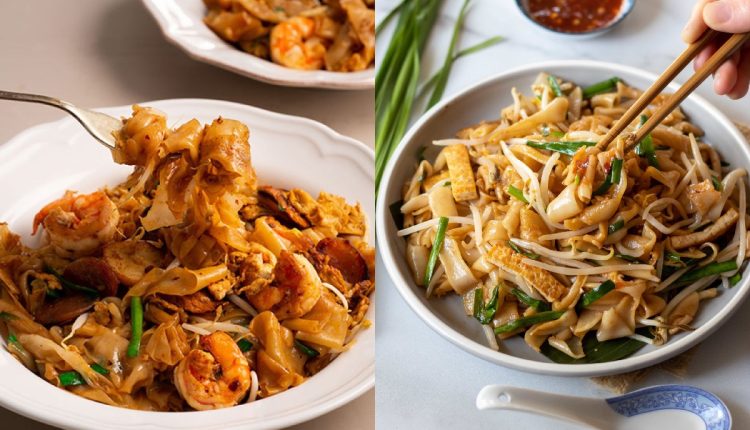Stir-Fried Magic: The Charm of Char Kway Teow
If you’ve ever wandered through the bustling night markets of Malaysia or Singapore, chances are you’ve caught a whiff of something rich, smoky, and deeply savory wafting through the air. That tantalizing aroma likely came from a wok loaded with Char Kway Teow, one of Southeast Asia’s most iconic and soul-satisfying noodle dishes.
A perfect plate of Char Kway Teow is an orchestra of flat rice noodles, Chinese sausage, shrimp, eggs, garlic, soy sauce, and bean sprouts, all stir-fried at searing heat with the distinctive magic of wok hei—the smoky “breath of the wok.”
Origins: A Dish Born from the Streets
The name “Char Kway Teow” translates from Hokkien as “stir-fried flat rice noodles.” It originated among Chinese laborers in Penang, Malaysia, who needed high-calorie meals that were quick and affordable.
It has since evolved into a regional delicacy loved across Malaysia, Singapore, and Indonesia, while also making appearances in Thai and Chinese food scenes with local variations.
Once a poor man’s dish, it is now a culinary superstar, served in both hawker stalls and high-end restaurants.
Key Ingredients That Make It Authentic
-
Flat Rice Noodles (Kway Teow) – Thick, chewy, and perfect for absorbing sauce and smoky wok flavor.
-
Chinese Sausage (Lap Cheong) – Sweet and savory, it adds a unique bite.
-
Fresh Shrimp or Cockles – Seafood is a key character in the dish.
-
Dark Soy Sauce & Light Soy Sauce – For color and umami richness.
-
Eggs & Garlic – To build the base flavors.
-
Bean Sprouts & Chives – For crunch and freshness.
-
Optional Chili Paste – Adds a spicy kick.
How to Make Char Kway Teow at Home
Ingredients (Serves 2):
-
200g flat rice noodles (fresh or soaked dry)
-
1 Chinese sausage, thinly sliced
-
6–8 medium prawns, cleaned
-
2 garlic cloves, minced
-
1 egg
-
1 cup bean sprouts
-
A handful of garlic chives (or spring onions), cut into 2-inch lengths
-
2 tbsp light soy sauce
-
1 tbsp dark soy sauce
-
1 tsp oyster sauce
-
1 tsp chili paste (optional)
-
2 tbsp cooking oil
-
Pinch of white pepper
Cooking Method:
-
Heat a wok over high heat until smoking. Add 1 tbsp oil.
-
Sauté garlic and sausage for 30 seconds.
-
Add prawns and stir-fry until just cooked.
-
Push ingredients to the side, add a bit more oil, and crack in the egg. Scramble it slightly before mixing.
-
Add noodles, sauces, and chili paste. Toss quickly.
-
Add bean sprouts and chives, stir-fry for just 30 seconds.
-
Finish with a pinch of white pepper and serve hot with lime wedges or pickled green chilies.
Wok Hei: The Soul of Char Kway Teow
True Char Kway Teow is all about the “wok hei”—the intense, smoky aroma that comes from cooking over a high-flame wok. It’s not just about heat but technique and timing. That’s why the best versions are often found on the streets where decades of practice have refined the skill to perfection.
Pro Tip: If you’re cooking at home, use a carbon steel wok and crank up your stove to its highest heat. Don’t crowd the pan!
Street Food to Soul Food: Why We Love It
-
Affordable Luxury: Simple ingredients become gourmet through skillful technique.
-
Deep Flavors: Sweet, salty, spicy, umami, and smoky—all in one bite.
-
Textural Delight: Soft noodles, crunchy sprouts, juicy prawns, and crispy edges.
-
Cultural Icon: It represents the melting pot of Chinese-Malay-Indian influences in Southeast Asia.
Global Appeal, Local Love
Char Kway Teow is no longer just a Malaysian street food—it’s a global culinary sensation, featured in food vlogs, fusion restaurants, and cultural festivals across the world. Yet, it still holds the most power in its hometowns—served hot, fast, and full of character by elderly uncles in pushcarts and smoky hawker stalls.
Pair It With:
-
Iced Milo or Kopi – A classic Malaysian combo.
-
Cucumber-onion salad – For freshness.
-
Pickled green chilies – To cut the richness.
Tips for a Perfect Plate:
-
Don’t over-stir. Let the noodles sear to get caramelized edges.
-
Use day-old or cold noodles if possible—they hold shape better.
-
Add cockles if you want traditional authenticity.
Final Bite
Char Kway Teow is more than a noodle dish—it’s history in a wok, a dance of fire and flavor, and a love letter to Southeast Asia’s food culture. Making it at home can be a thrilling experience, but nothing beats the version dished out at a street stall under the glow of night lamps and wok flames.
So, the next time you crave something deeply flavorful, a little indulgent, and packed with character—stir up a plate of Char Kway Teow, and let the wok do the storytelling.


Comments are closed.